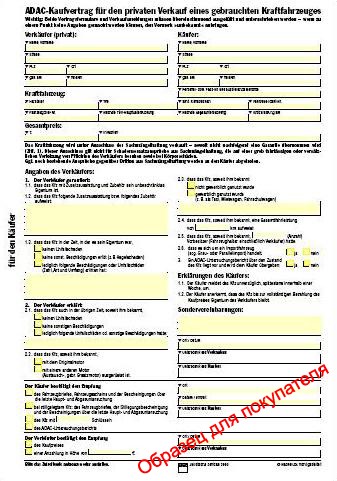
How to create a bill of sale to sell your car
Content
A bill of sale is especially important when selling high-value goods such as used cars. You will need a computer, printer, photo ID, and a notary.
A bill of sale comes in handy when selling items, such as a used car, to another party. A bill of sale is proof of the exchange of goods for money and requires special wording to ensure that all parties are covered. Keeping in mind what goes into writing a bill of sale, you can write it yourself without hiring a professional.
Part 1 of 3: collecting information for bill of sale
Necessary materials
- Desktop or laptop
- Paper and pen
Title and registration
Functions: Before writing a bill of sale, check with your local or state laws to find out what is required in your area when selling goods to another person. Be sure to include these requirements in your check when writing it.
Before writing a bill of sale, it is necessary to collect certain information. For used vehicles, this includes various identifying information, descriptions of any problem areas on the vehicle, and information about who is or is not responsible for them.
- FunctionsA: When gathering paperwork to write a bill of sale, take the time to make sure items such as the name of the vehicle are in order. This can give you time to fix any issues before it's time to complete the sale.
Step 1. Gather vehicle information.. Gather vehicle information from the title, such as VIN, registration certificate, and other relevant information, including the make, model, and year of the vehicle.
Also, be sure to write down any damage to the vehicle that the buyer will be responsible for.
Step 2: Get the personal information of buyers and sellers. Find out the full name and address of the buyer to be included in the bill of sale, and if you are not the seller, then his full name and address.
This information is required because the name of the entities involved in the sale of an item, such as a used car, is an integral part of legalizing any such sale in many states.
Step 3: Determine the price of the car. Define the price of the item to be sold and any terms of sale, such as how the seller pays.
You must also determine any special considerations at this time, including any warranties and their duration.
Part 2 of 3: Write a bill of sale
Necessary materials
- Desktop or laptop
- Paper and pen
After you have collected all the necessary information, it's time to write the bill of sale. Use a computer to make it easier to edit the document after you're done. As with all documents on a computer, keep a copy for your records by scanning the document after signing, once everything is complete.
Step 1: Enter the sales invoice at the top. Using a word processing program, type Bill of Sale at the top of the document.
Step 2: Add a short description. The title of the document is followed by a brief description of the item being sold.
For example, in the case of a used car, you must include the make, model, year, VIN, odometer reading, and registration number. In the description, you must also include any identifying characteristics of the item, such as any features of the vehicle, any damage to the vehicle, the color of the vehicle, etc.
Step 3: Add a Sales Statement. Add a sales statement listing all parties involved, including the seller's name and address, and the buyer's name and address.
Also indicate the price of the item being sold, both in words and in numbers.
Here is an example of a sales request. “I, (seller's full legal name) (seller's legal address, including city and state), as the owner of this vehicle, transfer ownership of (buyer's full legal name) to (buyer's legal address, including city and state) for the amount of (price of vehicle )"
Step 4: Include any conditions. Directly below the sales statement, include any conditions, such as any warranties, payment, or other information, such as a shipping method if it is not in the buyer's area.
It is also customary to include any special condition statuses in this section, such as assigning the "as is" status to a used car you are selling.
- Functions: Be sure to put each condition in a separate paragraph for clarity.
Step 5: Include an Oath Statement. Write a sworn statement that the information above is correct to the best of you (the seller) under penalty of perjury.
This ensures that the seller is truthful about the condition of the goods, otherwise he risks going to jail.
Here is an example of an oath statement. "I declare under penalty of perjury that the statements contained herein are true and correct to the best of my knowledge and belief."
Step 6: Create a Signature Area. Under oath, indicate the place where the seller, buyer and any witnesses (including a notary) must sign and date.
Also, include space for the address and phone number for both the seller and the buyer. Also, be sure to leave space below this area for the notary to place your seal.
Part 3 of 3: Review and sign the bill of sale
Necessary materials
- Desktop or laptop
- Paper and pen
- State notary
- Photo identification for both sides
- Printer
- Name
The final step in the sale and purchase process is to verify that all the information on it is correct, that the seller and buyer are satisfied with what it says, and that both parties have signed it.
In order to protect both parties, they must sign in the presence of a notary who acts as a witness that both parties voluntarily signed the bill of sale, signing it themselves and sealing it with the seal of their office. Public notary services usually cost a small fee.
Step 1: Check for errors. Before finalizing the bill of sale, review the bill of sale you created to make sure that all the information is correct and there are no spelling errors.
You should also consider having a third party review the documentation to ensure that all of the information provided is correct.
Step 2: Print copies of bill of sale. It is needed for the buyer, seller and any other parties involved in the transfer of goods between the parties.
In the event of a used vehicle sale, DMV will handle the transfer of ownership of the vehicle from the seller to the buyer.
Step 3. Allow the buyer to view the bill of sale. If there are any changes to them, make them, but only if you agree with them.
Step 4: Sign and date the document. Both interested parties must sign the document and date it.
If necessary, do this in front of a Notary Public who will then sign, date and affix their seal after both the seller and the buyer have affixed their signatures. Both parties will also need a valid photo ID at this stage.
Drafting bills of sale yourself can save you the cost of having a professional do it for you. It's important to make sure you're aware of all the issues a car has before you sell it so you can include that information in the bill of sale. Have a pre-purchase vehicle inspected by one of our experienced mechanics to ensure you know important vehicle information when drafting a sales invoice.
